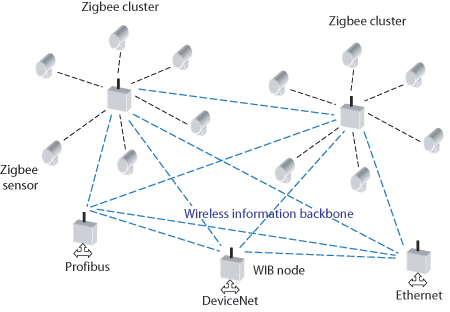Chapter 1: Basic Concepts of Wireless Communication
The communication method that uses the radiation and propagation of electromagnetic waves to transmit information through space is radio communication, also called wireless communication. Using wireless communication, communication services such as telegrams, telephones, faxes, data, images, and radio and TV programs can breathe transmitted.
Section I: Frequency Bands and Bands Used for Wireless Communications
Table 1: The frequency range and the band of electromagnetic waves used in wireless communications
| Band Name | Frequency Range | Wave Name | Wavelength Range | |
|---|---|---|---|---|
| Ultra High Frequency(UHF) | 300~3000MHz | Microwave | Decimeter Wave | 1~0.1m(1~10^(-1)m) |
| Super High Frequency(SHF) | 3~30GHz | Centimeter Wave | 10~1cm(10^(-1)~10^(-2)m) | |
| Extremely High Frequency(EHF) | 30~300GHz | Millimeter Wave | 10~1mm(10^(-2)~10^(-3)m) | |
| Tremendously High Frequency(THF) | 300~3000GHz | Submillimeter Wave | 1~0.1mm(10^(-3)~10^(-4)m) | |
| Light Wave | 3×10^(-3)~3×10^(-5)mm(3×10^(-5)~3×10^(-8)mm) | |||
For various reasons, some Western countries such as Europe, the United States, and Japan often divide part of the microwave band into L, S, C, X, Ku, K, Ka, and other bands (or sub-bands).
Table 2: The names of some of the microwave bands used in wireless communications
| Wave code | Frequency Range | Wavelength Range |
|---|---|---|
| L | 1~2GHz | 30~15cm |
| S | 2~4GHz | 15~7.5cm |
| C | 4~8GHz | 7.5~3.75cm |
| X | 8~13GHz | 3.75~2.31cm |
| Ku | 13~18GHz | 2.31~1.67cm |
| K | 18~28GHz | 1.67~1.07cm |
| Ka | 28~40GHz | 1.07~0.75cm |
Section 2: Electromagnetic Wave Propagation of Wireless Communication

The electromagnetic waves in wireless communication have different propagation characteristics depending on their wavelengths. The following is a description by wavelength.
1. Extremely Long Wave (Extremely Low Frequency, ELF) Propagation
Very long waves are electromagnetic waves with a wavelength of 1~100,000 km (frequency of 3~30 Hz). And also theoretical studies have shown that the electromagnetic waves in this band propagate along the land surface and in seawater with very little decay.
2. Ultra-long Wave (Super Low Frequency, SLF) Propagation
Ultra-long wave refers to the electromagnetic wave with wavelengths of 1,000 km to 10,000 km (frequency of 30~300Hz). The electromagnetic wave propagation in this band is very stable, and the attenuation in seawater is minimal (attenuation coefficient is 0.3dB/m when the frequency is 75Hz). The penetration ability of seawater is powerful and can reach a depth of more than 100m.
3. Very long-Wave (Very Low Frequency, VLF) Propagation
A very long wave is an electromagnetic wave with a wavelength of 10km~100km (frequency of 3~30kHz). The frequency of VLF used in wireless communication is 10~30kHz, and also the electromagnetic waves in this band can propagate in the waveguide formed between the earth and the lower ionosphere. The distance can reach thousands of kilometers or even cover the whole world.
4. Long-wave (Low Frequency, LF) Propagation
Long waves are electromagnetic waves with 1 km to 10 km (frequencies of 30 to 300 kHz). It also can propagate along the earth’s surface (ground wave) and by reflection from the ionosphere (sky wave).
5. Medium-wave (Medium Frequency, MF) Propagation
Medium waves are electromagnetic waves with a wavelength of 100m~1000m (300~3000kHz). Medium waves can propagate along the earth’s surface (ground waves) and by ionospheric reflection (sky waves). When the medium wave propagates along the ground surface, it is absorbed by the ground surface more severely than the longwave. Sky wave propagation of medium waves relates to diurnal variations.
6. Short-wave (High Frequency, HF) Propagation
A short wave is an electromagnetic wave with a wavelength of 10m~100m (frequency of 3~30MHz). Short waves also can propagate along the earth’s surface (ground waves), travel along with space in a direct or orbital manner (space waves), and reflect through the ionosphere (sky waves).
7. Ultra Short Wave (Very High Frequency, VHF) Propagation
Ultrashort waves are electromagnetic waves with a wavelength of 1m~10m (frequency 30~300MHz). Ultrashort waves are difficult to propagate by ground and sky waves but are mainly spread by direct radiation (the so-called “line-of-sight” method).
8. Microwave Propagation
A microwave is an electromagnetic wave with a wavelength less than 1 meter (frequency higher than 300 MHz). At present, it is also divided into sub-meter wave (UHF), centimeter wave (SHF), millimeter wave (EHF) and sub-millimeter wave (THF) according to its wavelength.
The microwave propagation is similar to the light wave propagation, which is a line-of-sight propagation. It takes place mainly in the troposphere.
This type of propagation is relatively stable, but its propagation is also affected by atmospheric refraction and ground reflection.
Also, the turbulent atmospheric air mass in the troposphere has a scattering effect on microwaves. This scattering effect can achieve the over-the-horizon propagation of microwaves.
WCDMA Working Band: 1920~1980MHz for uplink and 2110~2170MHz for downlink, which belongs to the microwave band, and its electromagnetic wave propagation is microwave propagation.
Chapter 2: Introduction to Common RF Calculation Units
Section I: Introduction to Power Units
1. The Absolute Power of dB is Shown.
The absolute power of the RF signal is usually expressed in dBm, dBW, and its conversion relationship with mW, W is as follows. For example, the signal power is xW, when using dBm to indicate the size of:
For example, the signal power is xW, using dBm expressed when its size is :
P(dBm)=10㏒(x×1000(mW)/1(mW))
P(dBW)=10㏒(x(W)/1(W))
For example, 1W equals 30dBm, which is equal to 0dBW. 1mW equals 0dBm.
2. Relative Power in dB
The relative power of the RF signal is often expressed in two forms: dB and dBc. The difference is that dB is the logarithmic representation of the ratio of any two powers. At the same time, dBc is the logarithmic representation of the balance of the output power of a frequency point and the output power of the carrier frequency.
Section 2: Introduction to Antenna Propagation Related Units
Antenna gain is generally expressed by dBi or dBd. dBi is the ratio of the power energy density of the antenna relative to the directionless antenna. dBd is the ratio of the power energy density relative to the half-wave oscillator Dipole, the gain of the half-wave oscillator is 2.15dBi, so 0dBd = 2.15dBi.
Section 3: Others
Resistance: An object or substance that blocks the passage of electric current, thereby converting electrical energy into heat or other forms of energy. Unit: Ohm, Ω.
Voltage: The potential or potential difference. Unit: Volt, V.
Current: The number of charges passing through a defined point on a circuit per unit of time. Unit: Ampere, A.
Inductance: The thing, usually a wire, around which a coil is wrapped and which, due to electromagnetic induction, can produce electric potential energy. Unit: Henry, H.
Capacitance: The maximum rate of charge that a charged insulated conducting object potentially has. Unit: Farad, F.

